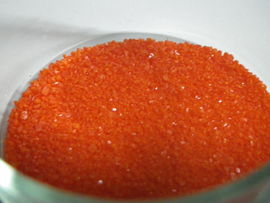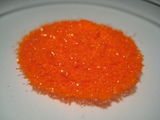Potassium dichromate
 Potassium dichromate sample.
| |
| Names | |
|---|---|
| IUPAC name
Potassium dichromate
| |
| Other names
Bichromate of potash
Chromic acid, dipotassium salt Dichromic acid, dipotassium salt Dipotassium dichromate Lópezite Potassium bichromate | |
| Properties | |
| K2Cr2O7 | |
| Molar mass | 294.185 g/mol |
| Appearance | Red-orange solid |
| Odor | Odorless |
| Density | 2.676 g/cm3 |
| Melting point | 398 °C (748 °F; 671 K) |
| Boiling point | 500 °C (932 °F; 773 K) (decomposes) |
| 4.9 g/100 ml (0 °C) 102 g/100 ml (100 °C) | |
| Solubility | Soluble in molten calcium nitrate, POCl3, selenium oxydichloride Slightly soluble in acetonitrile, ethylene glycol, liq. SO2 Insoluble in acetone, alcohols, ammonia, liq. AsBr3, carbon disulfide, liq. Cl2, chloroform, ethyl acetate, toluene, VOCl3 |
| Solubility in acetonitrile | 0.147092 g/100 ml[1] |
| Thermochemistry | |
| Std molar
entropy (S |
291.2 J·K−1 ·mol−1 |
| Std enthalpy of
formation (ΔfH |
-2,033 kJ/mol |
| Hazards | |
| Safety data sheet | Sigma-Aldrich |
| Flash point | Non-flammable |
| Lethal dose or concentration (LD, LC): | |
| LD50 (Median dose)
|
25 mg/kg (oral, rat) |
| Related compounds | |
| Related compounds
|
Ammonium dichromate Potassium chromate |
| Except where otherwise noted, data are given for materials in their standard state (at 25 °C [77 °F], 100 kPa). | |
| Infobox references | |
Potassium dichromate is the dichromate salt of potassium. It is a bright orange crystalline solid. It is commonly used as an oxidizing agent, especially in organic chemistry.
Contents
Properties
Chemical
Potassium dichromate is a powerful oxidizing agent, containing chromium in the +6 oxidation state. It may react violently with reducing agents, such as finely divided metals, making it a viable ingredient in flash powder. In solution, the orange dichromate ion exists in equilibrium with chromate, with dichromate dominant in acidic conditions. In extremely acidic conditions, trichromate will form.
Potassium dichromate can be used along with sulfuric acid in the Jones oxidation to oxidize primary alcohols to aldehydes, and secondary alcohols to ketones. The dichromate is reduced to Cr(III) in these reactions, the solution changing from orange to green. [2] This is the basis of how some breath analyzers work: by oxidizing the ethanol present in their breath to acetic acid, and reducing the dichromate to Cr(III).
Use as a Cleaning Agent
When potassium dichromate is combined with sulfuric acid, chromic acid, which is actually a combination of several compounds, is formed. This mixture can be used for cleaning glassware, usually when the glassware has insoluble organic residues on it. For example, it will oxidize carbon to carbon dioxide, effectively erasing it. It is advisable to not use chromic acid for cleaning glassware unless it is really necessary to, because of the high toxicity and corrosiveness of hexavalent chromium.[3]
Physical
Potassium dichromate is a bright orange crystalline solid under normal conditions. It melts at 398°C. It is soluble in water at 4.9 g/100 ml at 0°C and 102 g/100 ml at 100°C.[4] It shows poorly solubility in 1-methyl-3-butylimidazolium hexafluorophosphate (0.28 g/100 ml)
Availability
Potassium dichromate can be bought online for a reasonable price from sources like Elemental Scientific.[5] It is also a fairly common chemical used in ceramics, and can be purchased from ceramics stores directly or ceramics suppliers online, often at a cheaper price than that used for labwork.
Potassium dichromate occurs in nature as the rare mineral Lopezite. It can be found in some nitrate ores from the Atacama desert.
Preparation
Potassium dichromate can be produced from stainless steel from dinnerware or cooking implements, which contains a minimum of 10.5% chromium by mass. First, the entire piece of stainless steel is dissolved in a hot, concentrated acid, such as sulfuric or hydrochloric acid. The resulting solution should be dark green due to the chromium(III) ion. Sodium carbonate (not sodium hydroxide) is added to the solution to neutralize all remaining acids and precipitate a mixture of iron and chromium hydroxides, which are then filtered and washed. At this point, the washed mixture can be added to either potassium hypochlorite or sodium hypochlorite solution, which will oxidize the chromium(III) ions to chromate(CrO42-) ions, bringing them into solution. This forms either potassium chromate or sodium chromate. Once the yellow filtrate is collected, a strong acid can be added to reduce the pH of the solution, producing a solution of potassium dichromate or sodium dichromate, depending on the hypochlorite used earlier. If sodium hypochlorite was used and potassium dichromate is instead desired, a solution of potassium chloride can be added and the mixture cooled, precipitating orange dichromate crystals. This procedure should be done outside or in a fume hood, as chlorine gas is produced during both the hypochlorite and acid additions, and protective equipment should be worn due to the carcinogenic nature of hexavalent chromium.
If one wishes to prepare potassium dichromate from the sometimes-cheaper sodium dichromate, a saturated solution of either potassium chloride or potassium nitrate can be added to a saturated solution of sodium dichromate. Potassium dichromate will then crystallize out as the solution evaporates.
An important note on this process is that during the acidification of chromate to dichromate, excess acid must not be added in to great an amount if the solution is going to be boiled down and concentrated, as hot, acidic conditions will reduce the chromium(IV) back to chromium(III).
Projects
- Make chromic acid
- Make flash powder
- Make potassium chromate
- Make Chromium trioxide
- Make ammonium dichromate
Handling
Safety
Potassium dichromate, like all other hexavalent chromium compounds, is highly toxic and carcinogenic on ingestion or inhalation. Handling it can cause dermatitis, and it could also be absorbed through the skin in small amounts, usually if wet. Always wear gloves and goggles when handling it, and a dust mask or respirator when handling it as a powder to avoid inhalation of it, which could be fatal.
Storage
Potassium dichromate should be kept in plastic containers, with a proper label and a hazard symbol.
Disposal
Hexavalent chromium compounds are also hazardous to the environment. They should be disposed of as toxic waste after being reduced to chromium(III), which is less toxic. This reduction can be easily accomplished using ascorbic acid or sulfites.
Gallery
References
- ↑ Taura, Toshiaki; Inorganica Chimica Acta; vol. 98; (1985); p. L15 - L16
- ↑ http://en.wikipedia.org/wiki/Potassium_dichromate
- ↑ http://en.wikipedia.org/wiki/Chromic_acid
- ↑ CRC Handbook of Chemistry and Physics, 66th Edition
- ↑ http://www.elementalscientific.net/store/scripts/prodView.asp?idproduct=2419
